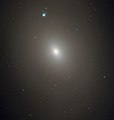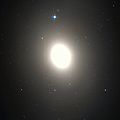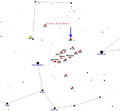| Messier 85 | |
|---|---|
 M85 by Hubble Space Telescope | |
| Observation data (J2000 epoch) | |
| Constellation | Coma Berenices |
| Right ascension | 12h 25m 24.0s[1] |
| Declination | +18° 11′ 28″[1] |
| Redshift | 729 ± 2 km/s[1] |
| Distance | 60 ± 4 Mly (18.5 ± 1.2 Mpc)[2] |
| Apparent magnitude (V) | 10.0[1] |
| Characteristics | |
| Type | SA(s)0+ pec[1]/E2[3] |
| Apparent size (V) | 7′.1 × 5′.5[1] |
| Other designations | |
| NGC 4382, UGC 7508, PGC 40515[1] | |
Messier 85 (also known as M85 or NGC 4382 or PGC 40515 or ISD 0135852) is a lenticular galaxy, or elliptical galaxy for other authors,[3] in the Coma Berenices constellation. It is 60 million light-years away, and it is estimated to be 125,000 light-years across.
It was discovered by Pierre Méchain in 1781. It is the northernmost outlier of the Virgo cluster discovered as of 2004.
Properties
M85 is extremely poor in neutral hydrogen[4] and has a very complex outer structure with shells and ripples that are thought to have been caused by a merger with another galaxy that took place between 4 and 7 billion years ago,[4] as well as a relatively young (<3 billion years old) stellar population on its centermost region, some of it in a ring, that may have been created by a late starburst.[5]
While indirect methods imply that Messier 85 should contain a central supermassive black hole of around 100 million solar masses,[6] velocity dispersion observations imply that the galaxy may entirely lack a central massive black hole.[7]
The type I supernova, 1960R was discovered in M85 on December 20, 1960 and reached an apparent magnitude of 11.7 (its effect in the telescope-resolvable sky to outshine most red dwarves a million times closer).
This galaxy has also been the host of the first luminous red nova identified as such, M85 OT2006-1. It was discovered on January 7 of 2006 and took place on the outskirts of this galaxy.[8]
On 25th June 2020, the ATLAS telescope in Hawaii spotted a type Ia supernova 2020nlb in M85, which reached a peak magnitude of 15.7. [9] [10] [11]
M85 is interacting with the nearby spiral galaxy NGC 4394, and a small elliptical galaxy called MCG 3-32-38.[12]
Gallery
Messier 85 properties lie somewhere between those of a lenticular and an elliptical galaxy.[13]
References
- ^ a b c d e f g "NASA/IPAC Extragalactic Database". Results for Messier 85. Retrieved 2006-11-18.
- ^ J. L. Tonry; A.Dressler; J. P. Blakeslee; E. A. Ajhar; et al. (2001). "The SBF Survey of Galaxy Distances. IV. SBF Magnitudes, Colors, and Distances". Astrophysical Journal. 546 (2): 681–693. arXiv:astro-ph/0011223. Bibcode:2001ApJ...546..681T. doi:10.1086/318301. S2CID 17628238.
- ^ a b Kormendy, John; Fisher, David B.; Cornell, Mark E.; Bender, Ralf (2009). "Structure and Formation of Elliptical and Spheroidal Galaxies". Astrophysical Journal Supplement. 182 (1): 216–309. arXiv:0810.1681. Bibcode:2009ApJS..182..216K. doi:10.1088/0067-0049/182/1/216. S2CID 119273143.
- ^ a b Hibbard, J. E.; Sansom, A. E. (2003). "A Search for H I in Five Elliptical Galaxies with Fine Structure". The Astronomical Journal. 125 (2): 667–683. arXiv:astro-ph/0211003. Bibcode:2003AJ....125..667H. doi:10.1086/345822. S2CID 14748737.
- ^ Fisher, David; Franx, Marijn; Illingworth, Garth (1996). "Line Strengths and Line-Strength Gradients in S0 Galaxies". Astrophysical Journal. 459 (1): 110. Bibcode:1996ApJ...459..110F. doi:10.1086/176873.
- ^ Kormendy, John; Bender, Ralf (2009). "Correlations between Supermassive Black Holes, Velocity Dispersions, and Mass Deficits in Elliptical Galaxies with Cores". Astrophysical Journal Letters. 691 (2): L142–L146. arXiv:0901.3778. Bibcode:2009ApJ...691L.142K. doi:10.1088/0004-637X/691/2/L142. S2CID 18919128.
- ^ Gultekin, Kayhan; Richstone, Douglas O.; et al. (2011). "Is There a Black Hole in NGC 4382?". Astrophysical Journal. 741 (1): L142–L146. arXiv:1108.1808. Bibcode:2011ApJ...741...38G. doi:10.1088/0004-637X/741/1/38. S2CID 411264.
- ^ Kulkarni, S. R.; Ofek, E. O.; Rau, A.; Cenko, S. B.; et al. (2007). "An unusually brilliant transient in the galaxy M85". Nature. 447 (7143): 458–460. arXiv:0705.3668. Bibcode:2007Natur.447..458K. doi:10.1038/nature05822. PMID 17522679. S2CID 4300285.
- ^ "AstroNote 2020-126". ATLAS20qoq (AT2020nlb): discovery of a candidate SN in MESSIER 85 (17 Mpc). Retrieved 2020-06-26.
- ^ "Messier 85". SEDS: Galaxy M85. Retrieved 2010-02-23.
- ^ "SN 2020nlb". SIMBAD. Centre de données astronomiques de Strasbourg. Retrieved 2010-02-23.
- ^ "M85, Lenticular Galaxy". Messier's Nebulae and Star Clusters. Retrieved 2009-03-29.
- ^ "The darkness within?". www.spacetelescope.org. Retrieved 4 February 2019.
External links
- Messier 85 on WikiSky: DSS2, SDSS, GALEX, IRAS, Hydrogen α, X-Ray, Astrophoto, Sky Map, Articles and images
- SEDS Lenticular Galaxy M85
- Merrifield, Michael. "M85 – Lenticular Galaxy". Deep Sky Videos. Brady Haran.






.jpg)